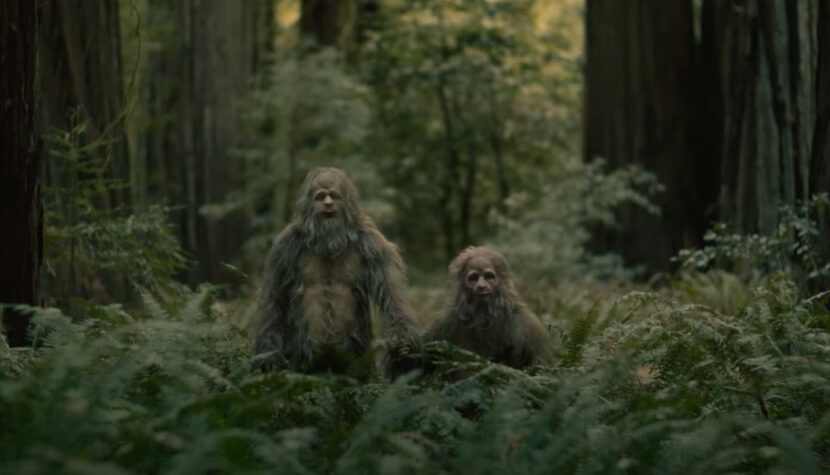SASQUATCH SUNSET. Big Foot’s little adventures

Have you ever wondered what a prehistoric sequence of “2001: A Space Odyssey” would look like if it were expanded into a full-length feature, and Kubrick showed a bit less pretension and a bit more humor in its execution? People in ape costumes wouldn’t be tossing a large bone into the air, but engaging in sex and defecating under trees. Instead of the most famous match cut in cinema history, for just under 90 minutes, we’d watch primitive communal life centered around the search for food and other basic physiological activities. David and Nathan Zellner have just made such a film: an anthropological comedy-drama about the secret existence of mythical creatures. Simple as a proverbial club, yet brimming with creativity.
It would probably be difficult to find among American filmmakers greater enthusiasts of the legend of Bigfoot than the Zellner brothers. Their directing career gained momentum after the four-minute “Sasquatch Birth Journal 2,” presented at the Sundance festival. The film was accompanied by an extensive art installation (Sasquatch Birth Journal 1), focused – like the aforementioned short – on the birthing process of the titular creatures. The feature-length “Sasquatch Sunset” is the fulfillment of their cinematic dreams. A derivative of childhood fascinations and obsessions – the bold, heartfelt script lay dormant in a drawer for several years. Its realization could only come about when the brothers established themselves in the industry, directing “Kumiko, the Treasure Hunter” and “Damsel,” and signing a contract to direct several episodes of “The Curse.”
The Zellner’s screenplay (specifically David Zellner’s) is bold because it’s entirely devoid of dialogue. Characters communicate through grunts, murmurs, and groans. They use simple gestures, constructing the beginnings of a nonverbal language. Hollywood actors disappear behind elaborate costumes and even more elaborate makeup – anyone who recognizes Jesse Eisenberg or Riley Keough in any of the characters gets a gold star. Observing the titular sasquatches, we experience a similar kind of satisfaction to watching animals in a zoo (this phenomenon was thoroughly analyzed by Bert Haanstra in a short documentary). We are delighted and fascinated when we see reflections of human behavior in animal activity, magnified by the dominance of instinct and the absence of cultural inhibitions. This allows us to look at things from a different perspective and ultimately better understand the social structures and processes that we typically take for granted.

The idea on which “Sasquatch Sunset” is based is splendid but risky. At first glance, it may seem like a surefire hit, but it risks quick exhaustion and weariness. The Zellner’s film avoids this trap for two reasons. Firstly: it’s relatively short (88 minutes), not dragging on for over two hours, exploiting the concept to the fullest. Secondly: the initial idea is followed by a whole range of great side ideas: both on a micro scale (numerous situational gags) and macro (structure). The plot is divided into 12 months in the life of a sasquatch, with the names of the seasons separating four narrative sequences. Thus, an important but secondary theme of the film becomes the circle of life, the merciless nature of natural laws – further emphasized by the presence of birth and death scenes.
The Zellner’s skillfully balance between seriousness and shameless, purely slapstick humor. At one moment we watch as characters throw excrement at each other, in another – as they mourn the shocking death of a member of the group. “Sasquatch Sunset” is therefore simultaneously a comedy with fecal elements and a drama, in which loneliness and a sense of existential emptiness (the sheer absurdity of existence) play an important role, heightened by majestic shots of nature. As they traverse the vast expanses of the forest, the creatures stop from time to time and, in a quasi-religious ritual, strike sticks against the bark of trees – thus seeking other members of their species. Instead of more sasquatches, they find traces of human presence. A decaying tent, felled trees, scorched earth. In such moments, “Sasquatch Sunset” takes on the character of an ecological post-apocalypse – the characters explore a ravaged (due to human actions) planet, taking refuge in the last shreds of virgin nature. Their fate seems predetermined, as not only the exceptionally bitter ending reminds us, but also the title of the film. As you can see – with the Zellners it’s like with the Daniels (the authors of “Swiss Army Man” and “Everything Everywhere All at Once”). A little goodwill is enough to see beyond the absurdity and grotesque and discover a sea of more serious content.

Outstanding brotherly duos are currently going through a difficult period in cinema. The Safdie brothers announced a few months ago that they were parting ways on an artistic level – Josh is to focus on directing, while Benny will dedicate himself to an individual acting career. The Coen brothers suspended their collaboration several years ago, although according to the latest reports, there is a chance that they will create a joint project in the near future. Fortunately, the Zellner brothers are just getting started: they kick open the doors to the world of cinema with a swift kick, dressed from head to toe in hairy sasquatch costumes. Their latest work is, as Peter Debruge from “Variety” rightly pointed out, a “unicorn film”: it’s hard to believe in its existence until you see it with your own eyes.
By the way: it was touch and go for “Sasquatch Sunset,” as it could have shared the fate of said unicorn and remained forever in the realm of imagination. When one of the main sponsors withdrew funding, the project was supported by individual enthusiast producers: Ari Aster and Jesse Eisenberg. At the crucial moment, the actor put up his own money, ensuring that the crew went on set and started shooting according to schedule. Thanks to this, the Zellners can continue to develop – to their benefit, ours, and the benefit of cinema.

